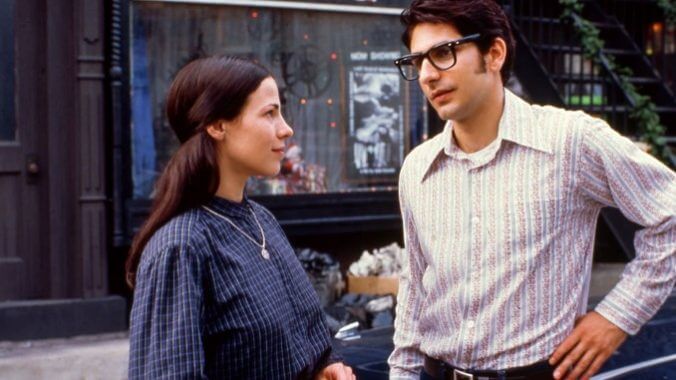A Guide to Recognizing Household Saints and Director Nancy Savoca

People see Jesus Christ in whatever suits their need for their faith’s validation: Water-stained plaster; toast; the lid of a Marmite jar; a Walmart receipt. In Nancy Savoca’s Household Saints, he makes a personal appearance in one character’s living room as they iron the laundry. It’s the film’s only overt instance of holy visitation, but it’s enough to invite us to reconsider little details, like a perfect pinochle hand, as proof of the divine. Savoca filters these moments through the idiosyncratic tale of one Italian American couple’s union, and their daughter’s lifelong striving for sainthood. Becoming a bride of Christ isn’t easy. Watching your child try isn’t, either, but at least her efforts pay off by blessing the family business, a butcher shop, with heavenly sausages.
In accordance with the family’s background, their story isn’t just their story. It’s their friends’ and neighbors’ story, too, in the sense that they’ll regale anyone who will listen to them, applying little tweaks and edits in the telling. Household Saints is about the way stories change in each narration, rooted in the mores of Italian American life: hotheaded conflicts over nothing, heaving sexual advances, and religious superstitions held by the people who remember the old country, and rejected by the ones who never knew it. The film is a document of culture shift, where the younger generation cuts ties with the incumbents’ customs to sculpt their own; as such, it’s a film about cycles, bookended by a prologue and epilogue set decades after its events.
Given a limited release in 1993, Household Saints is back in theaters now in a shiny new 4K restoration from Philadelphia’s Lightbox Film Center at University of the Arts, released by Kino Lorber and Milestone Films. 2024 is as good a moment as any for a production lost in the shuffle of the 1990s’ upsurge of indie cinema. Remember Fine Line Features, the indie-flavored arm of New Line Cinema? You may not; New Line and fellow Time Warner subsidiary HBO Films merged into Picturehouse in 2005, and Fine Line got swallowed up in the process, then swallowed again by Warner Home Video when New Line shuttered five years later.
Fine Line movies like The Player, Hoop Dreams and My Own Private Idaho survived the crush and grind of these moving parts, by virtue of their membership in contemporary cinema canons. Household Saints had no such fortune, so it’s a relief to see a film buried in the past freshened up for the present. For those who haven’t seen it, it’s a lovely slice-of-life picture, stacked with performances beaming low-key urgency. For Savoca and Richard Guay, her co-writer and husband of 44 years, the experience of seeing Household Saints today, bright, vital and warm anew, has been somewhat more meaningful than that.
“In some ways, for me, it almost feels like a new movie,” says Guay, who, along with Nancy, spoke to Paste by Zoom. “30 years ago, we had a very good release at the time. But the level of interest is really quite something.” He pauses to search for the right word to put to the feeling; Savoca jumps in to finish his sentence, proof of their seasoned relationship and partnership. “We’re really surprised, honestly.”
“I love hearing from somebody seeing it for the first time,” Savoca adds. “What’s that like?” She and Guay are naturally close to Household Saints, a product of its era of filmmaking. Like many restorations, the movie functions a bit like a time capsule when contextualized in the present, though the period setting gives it a quality Savoca describes as “a room full of mirrors.” Household Saints is a film from the past, about the past; it doesn’t reflect the 1990s in terms of its content, but in its aesthetic. “I think it is evocative of a kind of movie that got made when there were a lot more risk takers,” Guay points out. “I don’t know if this movie would get made today, but in the [1990s], there were a lot of these kinds of really interesting, really different, sort of movies being made.”
Guay notes that plenty of interesting movies are being made today, too, but the point stands that the 1990s, theatrically and in the home video market, were a friendlier time for independent movies like Household Saints, something that Jesse Pires, Director & Curator of Lightbox Film Center, cites as a systemic factor. “The 1990s indie film boom brought so many more voices and perspectives to the fore,” Pires explains. “Stories that might not have made it to the big screen before were now finding audiences, and there was an infrastructure there to get it out to people.” As the century turned, so did the attention of viewers and the industry, as the 2000s ushered in a golden age of television with shows like The Sopranos and Six Feet Under.
The new environment was inhospitable for Household Saints, and Savoca’s work fell into unjust obscurity. Consequently, Pires considers the film “forgotten,” and not so much “lost” like other recent restorations. (See: Tokyo Pop.) “The more time that passes, the more important it is to return to some of these ‘forgotten’ works and see them for the modern day classics that they are,” Pires says.
For Household Saints, preservation means confronting the established order, according to Dennis Doros and Amy Heller, Milestone’s co-founders. (In a nice reflection of the film’s pattern motif, they, like Savoca and Guay, are also married.) “We’re challenging the canon,” Heller says. “We’re calling attention to films and filmmakers that have been overlooked, to genres, to filmmaking communities, to lots of things that have been overlooked.”
-

-

-

-

-

-

-

-

-

-

-

-

-

-

-

-

-

-

-

-

-

-

-

-

-

-

-

-

-

-

-

-

-

-

-

-

-

-

-

-








































